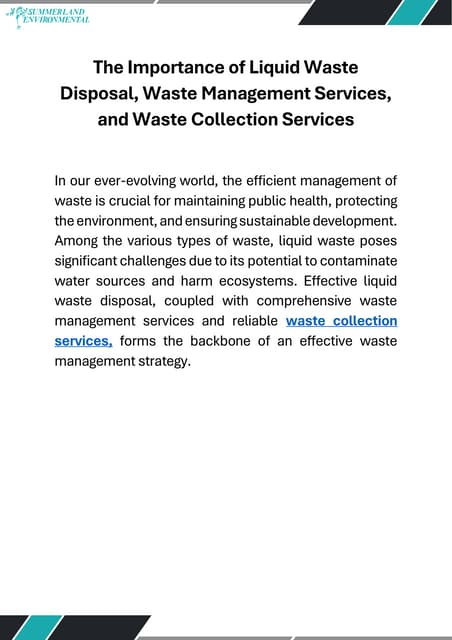7 Simple Techniques For Reclaim Waste
Table of ContentsReclaim Waste Fundamentals ExplainedReclaim Waste - The FactsReclaim Waste - An OverviewThe smart Trick of Reclaim Waste That Nobody is Talking AboutFascination About Reclaim Waste
Domestic sewer waste refers to the waste and products from a household septic container. The appropriate management and disposal of residential sewage waste call for liquid waste to be transferred to a sewage treatment plant where the appropriate approaches and devices are used to detoxify and dispose of waste.
Industrial waste often consists of possible threats, such as combustible products or a mix of liquid and solid waste products, and needs a more sophisticated and detailed disposal procedure. The disposal of commercial waste usually involves the filtration of waste before transport to make sure safe and appropriate disposal. Hazardous waste is produced from results and drainage of commercial procedures and manufacturing.
This kind of waste can not use the same sewage administration transportation or processes as septic or industrial liquids. The hazardous waste monitoring process needs the assessment and screening of fluid waste prior to it goes through the disposal process (industrial wastewater treatment). Overflow waste is the fluid waste that comes from runoff and excess stormwater in extremely inhabited areas or cities
Drainage waste can cause contamination and flooding otherwise handled appropriately. Discover more concerning drain cleaning and waste monitoring. Guaranteeing proper waste monitoring can stop calamities and lower environmental damage. Both individuals in domestic settings and experts in industrial or production markets can take advantage of understanding the processes and guidelines of liquid waste administration.
The smart Trick of Reclaim Waste That Nobody is Discussing
Contact PROS Providers today to discover our waste administration and disposal solutions and the proper means to care for the fluid waste you generate.
(https://telegra.ph/Expert-Liquid-Waste-Disposal-and-Removal-Services-in-Melbourne-11-12)Do you know what takes place to your water when you draw the plug, flush the commode or drain the washing equipment? No? Well, it's worth recognizing. This supposed 'wastewater' is not only a vital resource but, after treatment, will certainly be released to our land, rivers or the ocean. Made use of water from bathrooms, showers, bathrooms, cooking area sinks, washings and industrial processes is known as wastewater.

water made use of to cool machinery or tidy plant and equipment). Stormwater, a kind of wastewater, is drainage that flows from agricultural and city areas such as roofing systems, parks, gardens, roads, courses and gutters into stormwater drains, after rainfall. Stormwater streams unattended straight to local creeks or rivers, eventually reaching the ocean.
9 Easy Facts About Reclaim Waste Shown
In Queensland, most wastewater is treated at sewage treatment plants. Wastewater is transported from domestic or industrial sites via a system of sewage systems and pump terminals, called sewerage reticulation, to a sewage treatment plant. Regional federal governments construct, keep and run most sewer therapy plants. Operators are certified under the Environmental Defense Act 1994 to release cured wastewater at an appropriate ecological criterion right into rivers.
The Division of Natural Resources advises city governments about managing, operating and maintaining sewerage systems and therapy plants. In unsewered locations, neighborhood federal governments might need owners to mount private or home sewage treatment systems to treat residential wastewater from toilets, kitchen areas, restrooms and washings. The Division of Natural Resources authorises making use of household systems when they are proven to be reliable.
In some brand-new class, treatment of some stormwater to eliminate trash, sand and gravel has actually begun utilizing gross pollutant catches. Wastewater treatment happens in four phases: Removes strong matter.
Wastewater after that flows into huge tanks where solids clear up and are removed as sludge. Oil and scum are skimmed from the surface. Makes use of small living microorganisms referred to as micro-organisms to damage down and eliminate remaining dissolved wastes and great fragments. Micro-organisms and wastes are integrated in the sludge. Gets rid of nitrogen and phosphorus nutrients that could create algal flowers in our rivers and intimidate water life.
Reclaim Waste for Dummies
Nutrient elimination is not offered at all sewage therapy plants due to the fact that it requires pricey specialized devices. Clear fluid effluent created after therapy may still include disease-causing micro-organisms - liquid waste disposal melbourne.

Many wastewater moves right into the sewage system. Under the Act, neighborhood federal governments carry out authorizations and licences for eco appropriate activities (Ages) including wastewater releases that could have a local impact.
The Greatest Guide To Reclaim Waste
Or else, examples are taken for lab analysis. Often several tests are required to develop the degrees of each of the various toxins such as oils, hefty metals and chemicals in water. Monitoring gives factual info regarding water navigate to this site high quality and can validate that permit problems are being satisfied. The details gotten through monitoring supplies the basis for making water high quality choices.